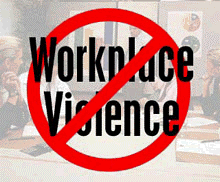By Sheena Williams
When you hear about violence in the news, it’s usually out in the streets or some far away country in an area that has nothing to do with you directly. Even if it’s closer to home, it’s always some other person who was abused by their spouse or someone else’s child getting picked on at school. No one ever thinks that it can happen to you, but it can. It can happen in some of the least likely places like your place of employment.
Workplace violence is any act or threat of physical violence, harassment, intimidation, or other threatening disruptive behavior that occurs at your place of business. It can be anything from threats and verbal abuse to physical assaults and even homicide. It can involve employees, clients, customers and visitors. Most people are not expecting it, and so, are unprepared for when it happens. Thousands of incidents of workplace violence take place every year and those are just the ones reported. There will never be a true count of how much goes on because so many cases go unreported every year. Here are some ways to reduce the risk of workplace violence for yourself and others.
Zero Tolerance of Workplace Violence
If you take the issue seriously from the start, then, there are less likely to be occurrences of it happening in the first place. See what your job’s policies are on violence in the workplace and see how they are treated and/or enforced. These policies should not only cover those who work there, but those who come inside as customers, clients, vendors, or just persons off the street. If you see that your job does not have a workforce violence program, see about starting one.
Be Aware of Your Surroundings
One of the dangers of being in your workplace when violence happens is that you are prepared for it. No one thinks that when they walk into their cubicle, workstation, or company bathroom that something is going to happen to them. Don’t walk around being paranoid, but always take stock of where you are. Note who is around you and what people are doing close to you. The easiest way to do this without causing a fuss is to say hello to people as you go by. It lets everyone know that you’re acknowledging them and that you see him or her without making a big deal about it.
Don’t Feed Into the Drama
Sometimes, a simple argument between employees can spiral out of control. Some might laugh at an argument starting over an individual running out of something innocent like post its, but when you work in a high stress environment, things can escalate very quickly. You don’t really know what is going to set someone off. Learn to know when a situation is going to get out of hand, and then, either avoid it or try to diffuse it. If you see two co-workers arguing, don’t jump into it. If you see someone getting hurt, if at all possible, call security prior to stepping in.
Documentation
 If you notice something of real concern, you should always alert your supervisor. Please make note of real concern. Your supervisor is going to become agitated if you report on Cindy having a nail file at the office, and everyone knows she does her nails at her desk on Thursdays while on the phone. If you see someone exhibiting seriously bad behavior that makes you feel uncomfortable, then, by all means, let your supervisor know that something is going on. You know when a situation is not right. It’s best to do it in writing, if at all possible, because you will have a date and time the issue was addressed.
If you notice something of real concern, you should always alert your supervisor. Please make note of real concern. Your supervisor is going to become agitated if you report on Cindy having a nail file at the office, and everyone knows she does her nails at her desk on Thursdays while on the phone. If you see someone exhibiting seriously bad behavior that makes you feel uncomfortable, then, by all means, let your supervisor know that something is going on. You know when a situation is not right. It’s best to do it in writing, if at all possible, because you will have a date and time the issue was addressed.
OSHA and YOU
 Make sure that your workplace has information available and posted for those coming in and out of the workplace. OSHA creates many pamphlets, brochures, and handouts that your office can secure at no cost regarding Occupational Safety and Health. They also offer different stress handling classes or safety awareness seminars throughout the year. If you ever have any questions regarding these policies, see the following information:
Make sure that your workplace has information available and posted for those coming in and out of the workplace. OSHA creates many pamphlets, brochures, and handouts that your office can secure at no cost regarding Occupational Safety and Health. They also offer different stress handling classes or safety awareness seminars throughout the year. If you ever have any questions regarding these policies, see the following information:
For a free copy of OSHA publications, send a self-addressed mailing label to this address:
OSHA Publications Office
P.O. Box 37535
Washington, DC 20013-7535
Or, send a request to fax number (202) 693-2498, or call (202) 693-1888.
To file a complaint by telephone, report an emergency, or get OSHA advice, assistance or products, contact your nearest OSHA office under the “U.S. Department of Labor” listing in your phone book, or call toll-free at:
(800) 321-OSHA (6742)
Tele-Typewriter (TTY) Number (877) 889-5627
To file a complaint online or obtain more information on OSHA federal and state programs, visit OSHA’s website.
In the end nothing can guarantee that you will not be a victim of Workforce violence, but hopefully these steps have given you ways to minimize the threat to yourselves and those around you. △
